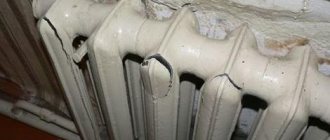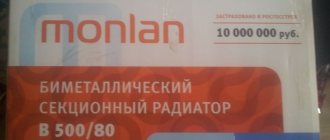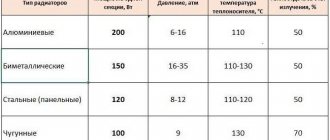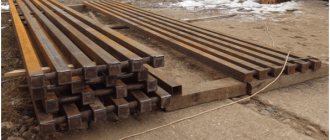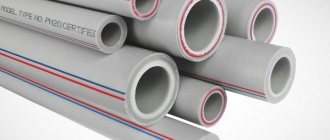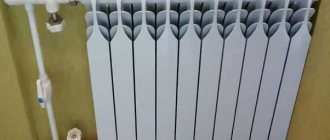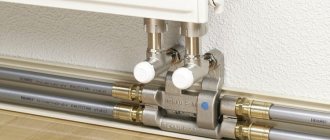A water heating radiator is a heating device, usually consisting of separate hollow sections, inside which hot water constantly circulates. Heat from the batteries enters the room in the form of thermal radiation followed by air convection.
The first models were products made of cast iron. A modern range of home water heating batteries of various designs allows developers to choose which heating radiators are best suited for an apartment based on local conditions.
Types of radiators
Among the huge variety of models, the consumer faces the problem of which heating batteries are best to choose for an apartment and which ones for a private home.
Types of batteries can be grouped according to the following characteristics.
- Material of manufacture;
- Device shape and placement method.
Material of manufacture
Heating devices are:
- cast iron;
- steel;
- aluminum;
- bimetallic;
- copper;
- plastic.
Cast iron
Sections of the first cast iron heating radiators can still be seen in old apartment buildings built during the Soviet period. The appearance left much to be desired. They were quite bulky and did not in any way decorate the interiors of the apartments.
Modern devices of this type have a stylish design and high heat output . Thanks to the cast iron structure, the radiator can withstand a critical pressure level of up to 30 atmospheres (A), which saves it from powerful water hammer and rupture of the housing.
Cast iron heats up quickly and releases heat slowly.
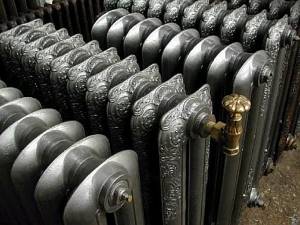
Cast iron products are “tolerant” of water quality and can withstand many years of operation with contaminated coolant. Thanks to the design, the batteries can be assembled and disassembled by varying the number of sections.
Steel
It is recommended to install a steel radiator in the apartment. They compare favorably with their cast iron “brothers” by being light in weight.
A significant disadvantage is susceptibility to corrosion.
The devices are designed for a maximum coolant temperature of 900 C. Steel batteries come in tubular and panel types. Both have a high degree of heat transfer.
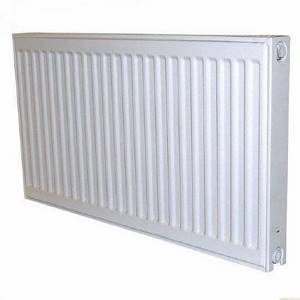
They heat up almost twice as fast as their cast iron counterparts, but they also cool down just as quickly. At the end of the heating season, water from steel radiators is not drained. This is done so that the inner surface of the product channels cannot rust from contact with air.
Panel models are not a collapsible structure, while tubular products can be replaced with sections or supplemented with new ones.

Aluminum
Aluminum heating devices for apartments are often a budget option. A battery made by extrusion cannot be repaired. Using the technology of squeezing molten metal into a mold, a one-piece device with flow channels is obtained.
The undeniable advantage of such radiators is fast heating, light weight and ease of installation. The metal of the products undergoes anodic oxidation, as a result of which a protective oxide film is created on the surface of the aluminum.
The disadvantages include the high cost of the products and the difficulty of connecting to steel pipes only through special couplings on the outside. Aluminum heaters are capricious in relation to the central heating coolant. Their channels can quickly become clogged with deposits of untreated hot water.
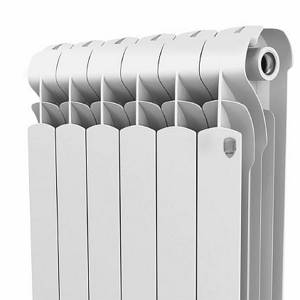
Bimetallic
The battery is made of two metals - steel and aluminum. The basis of the radiator is horizontal inlet and outlet steel tubes with transverse tubular channels, surrounded by aluminum converter plates.
The bimetallic design combines the best thermal properties of two metals. The steel, heated by the coolant, transfers heat to the aluminum plates. They release thermal energy into the air space of the apartment much faster than the steel body.
What's the gain here? The fact is that aluminum does not come into contact with the heat carrier liquid, thereby not being at risk of corrosion. This allows you to create efficient heat exchange and significantly increase the service life of heating devices.
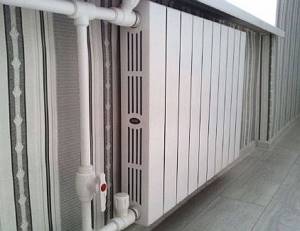
Copper
Copper is an excellent heat conductor that no other metal can compare with. A copper heat exchanger is an ideal device for heating rooms. Along with its magnificent appearance, the radiator lasts at least 25 - 30 years.
The metal surface has virtually no adhesion, so even dirty hot water does not leave any deposits in its tubes. Copper is absolutely indifferent to corrosion processes, withstands pressure in pipes of up to 36 atmospheres and temperatures above 1000 C. The only and significant drawback is the high cost of copper products.
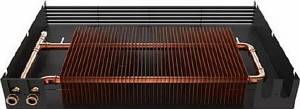
Plastic
Plastic radiators are today's novelty on the heating engineering market. In technical terms, new products are still significantly behind their counterparts made from other materials.
The operating temperature of the coolant in them should not exceed 800 C. The maximum pressure in the heating system should be less than 3 atm.
Despite this, plastic heating devices have a great future due to their advantages. Plastic products are several orders of magnitude cheaper than batteries made from other materials. They are easy to connect to plastic pipes. The material can be of any color, which makes it possible to give the interior an unusually beautiful color.

Device shape and placement method
Based on the shape of the device, radiators are divided into panel and tubular products (see the “Steel” chapter above).
As for the placement method, floor-standing devices rest on legs, and wall-mounted models are attached to vertical railings.
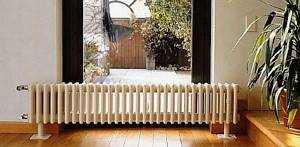
Floor radiators
Materials for the manufacture of heating devices
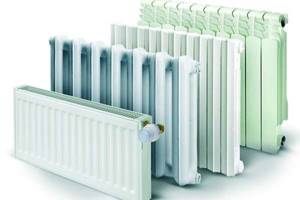
The main division of heating equipment for apartments occurs according to the material of manufacture. This parameter determines the performance characteristics of the batteries.
Aluminum
Batteries made of non-ferrous metal have a sectional design, are lightweight and provide better heat transfer. Aluminum radiators come in different heights, there are models up to 2 m. They are made by casting or extrusion. Considering the characteristics of the devices, they are recommended for houses of 3-5 floors. Radiators are not installed when the acidity of the coolant is above 7.5.
Pros:
- excellent thermal conductivity;
- health safety;
- little weight;
- ease of installation;
- resistance to external influences.
Minuses:
- cannot withstand water hammer;
- poor resistance to aggressive coolant impurities.
Steel
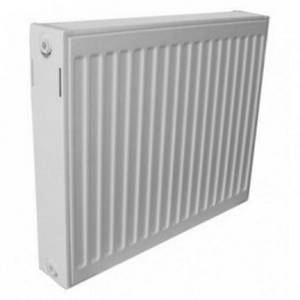
When choosing the best radiators for heating an apartment, many consumers choose steel tubular or panel structures. Modern radiators have good heat transfer and quickly warm up the room. They can be used in buildings up to 15 floors.
Pros:
- a large area of devices increases heat transfer;
- modern design;
- simple installation;
- affordable price.
Minuses:
- when pressure surges, a gust is possible;
- not all models are designed for high pressure.
Cast iron
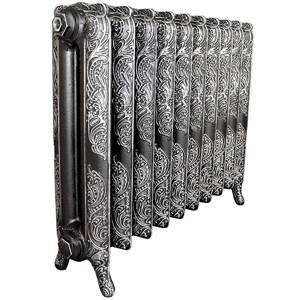
For the central heating water circuit, cast iron radiators remain the most acceptable option. They are resistant to sudden pressure changes and aggressive coolant compositions. Thermal inertia allows you to maintain the temperature for a long time in case of heating shutdown. Cast iron radiators are also suitable for an autonomous system with a gas boiler.
Pros:
- suitable for any heating systems;
- work with low-quality coolant;
- sectional design;
- resistance to water hammer and corrosion.
Minuses:
- significant weight;
- thermal inertia.
Bimetallic structures
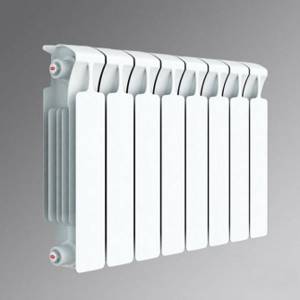
A new type of heating devices consists of two metals - aluminum and steel. Materials that provide optimal parameters are used in different parts of the structure. The pipes in contact with the coolant are made of steel. Durable metal can withstand increased operating pressure and is not afraid of corrosion. The outer part is made of aluminum, which quickly transfers heat.
Pros:
- fast heating of the structure;
- maximum pressure 25-35 atmospheres;
- light weight;
- stylish design;
- long-term operation.
Disadvantage: high cost.
An analysis of the characteristics of radiators made of various materials shows that bimetallic structures are the best choice for installation in apartments without limiting the number of floors in the building. The products have no significant drawbacks and are easy to install.
TOP 17 rating
Quite a few manufacturers offer their products on the Russian heating equipment market. Today, the list of the best heating radiators for an apartment includes devices from the following well-known manufacturers.
DO NOT BUY Radiators Until You See THIS!!!
- Thermo.
- Global STYLE PLUS.
- Sira.
- KONNER Modem.
- MS-140.
- FTV.
- Purmo Ventil.
- RETROstyle WINDSOR.
- Buderus Logatrend.
- Ogint Fortis.
- ROMMER Al Optima.
- ALP-500.
- Thermal Standard Plus.
- Oasis.
- KZTO.
- Lidea.
- Terma.
The heating radiators on this list are best suited for installation in an apartment in a multi-storey building.
Royal Thermo
One of the largest manufacturers of heating systems in Eurasia. The main production facilities of the Italian branch are located in the Vladimir region. The range of heating radiators produced by the company consists of 4 standard panel models with side and bottom connections.
Bimetallic batteries can be built into a heating system with any aggressive coolant. Aluminum models use a new technology for attaching the plug to the body without welding, which is the best today.
Global STYLE PLUS
The largest Italian manufacturer is represented on the Russian market with a wide range of heating batteries. Global Style Plus bimetallic radiators are installed in heating systems in the same way as steel appliances.
Using nipples, you can easily increase or decrease the number of sections directly at the installation site. The manufacturer's range also includes cast iron and steel models.
Sira
The Italian company Sira Group has been operating since 1959. Branches of its production facilities are located in different countries, including Russia.
The company specializes in bimetallic heating radiators. In the Russian heating engineering market it is known for such models as Gladiator.
KONNER Modem
This is a high-quality manufacturer of heating equipment, including aluminum batteries. Models are specially designed for individual heating systems. Their work is characterized by high heat transfer, reliability and ease of operation.
Radiators are manufactured according to international quality standards. All products are certified for compliance with Russian quality standards.
MS-140
The manufacturer PJSC Lugansk Foundry and Mechanical Plant still produces “Soviet” cast iron batteries. Despite the fact that the products have a long history, cast iron radiators are in great demand on the Russian market.
They are installed in rooms where there are no increased requirements for the appearance of devices. These are technical premises, workshops, etc. Their attractiveness lies in their high thermal characteristics and inexpensive price.
Kermi FTV
Kermi steel panel radiators attract buyers with a unique combination of affordable prices and beautiful design.
Products can be divided into two groups - these are devices with side and bottom connections. All of them are equipped with Mayevsky taps, plugs and wall mounting kits.
Purmo Ventil
The Finnish company Purmo Ventil is one of the leading European suppliers of heating systems, including apartment water heating batteries. The company is constantly involved in the development of innovative solutions for climate control equipment.
Panel steel radiators with convection elements at the ends are closed with protective strips and can be connected both from the side and from the bottom. To do this, there are two lower holes with internal threads in the panel or two inlets for hot water on the sides.
A distinctive feature of the models is the presence of thermostatic valve inserts.
RETROstyle WINDSOR
For many years, the Russian company Retrostyle has been producing the best cast iron radiators, made in the popular retro design style. The products are more intended for private houses and apartments in luxury high-rise new buildings.
The Windsor line represents batteries consisting of two-column sections on legs and with upper convection ears. Twisted relief patterns decorate the surface of the sections, which gives them special elegance and sophistication.
Buderus Logatrend
, located in the Saratov region, is part of the Bosch manufacturing company together with Buderus Logatrend.
The company specializes in the production of panel steel radiators of various sizes. Heating panels measuring 500 x 500 mm are very popular. At the same time, the plant produces wall-mounted boilers that are most compatible with heating radiators of the same name.
Ogint Fortis
The company's main production facilities are located in Southeast Asia. Ogint Fortis products include cast iron, bimetallic and aluminum radiators. Cast iron models are very popular in Russia.
They have a modern design. They are supplied to the market assembled from 7 – 10 sections. Designed for use with hot water and antifreeze. Developers purchase them in large quantities for installation in apartments in multi-storey new buildings.
Products undergo pre-sale tests and are supplied as a complete set for wall mounting.
ROMMER Al Optima
Aluminum radiators from ROMMER Al Optima are designed for use both in individual heating systems and in apartment buildings. The manufacturer strives to achieve maximum implementation of the best thermal conductivity qualities of aluminum in its products.
All products are manufactured in a trauma-safe design with rounded surfaces, which allows them to be installed in rooms with small children. The sections made by extrusion casting are capable of withstanding system pressures of up to 16 atm.
RIFAR ALP-500
The Russian company Rifar is the largest manufacturer of two lines of heating batteries. These are high-quality bimetallic and aluminum sectional radiators. The products have proven themselves well in almost all regions of Russia from Kaliningrad to Siberia and the Far East.
Of the entire range of heating devices, the bimetallic model Rifar ALP-500 attracts attention. The radiator constantly takes the best places in Russian ratings. The simple and at the same time beautiful design of the device can suit any apartment interior. Dimensions: 570 x 1360 x 75 mm. Lateral connection. Estimated price 4.4 thousand rubles.
Thermal Standard Plus
Aluminum radiators Thermal Standard Plus 500 are products of Zlatmash JSC, located in the Chelyabinsk region. The batteries, consisting of 5 sections, are manufactured as a single monolithic structure using the extrusion method of aluminum-magnesium alloy under a pressure of 2000 tons.
Due to this, the external and internal surfaces of the products are mirror clean. In addition to the standard configuration, models can have from 3 to 10 sections. The 5-section battery has dimensions of 531 x 73 x 395 mm.
Oasis
The production facilities of the Russian company Oasis are located in China and Volgograd. The company specializes in the production of aluminum and bimetallic radiators made by extrusion of aluminum alloy.
The devices are prefabricated products from several sections. The company sells products section by section with an installation kit. The BS 500/100 model is especially popular. Color white, maximum working pressure 25 atm. Weight of 1 section – 1.7 kg. Compatible with any centralized heating systems in apartment buildings.
KZTO
The Kimry Heating Equipment Plant "Radiator" is known for its original products. These are steel tubular radiators. The company specializes in the manufacture of heating equipment for individual orders.
In the assortment of factory products you can always find radiator and angular radiators with central or spaced bottom connections with individual installation of devices. "Harmony" radiators, coated with white polymer, can withstand pressure up to 15 atm.
You can order wall-mounted radiators with a bottom right or left connection, complete with plugs and a built-in thermal valve, from the factory or its distributor. Upon request, the company will produce floor heating radiators on legs with the same set of components.
Lidea
In addition to agricultural implements and equipment, Belarusian manufactures high-quality steel panel radiators. Products are exported to almost all CIS countries and foreign countries.
Steel heating radiators are produced in both wall-mounted and floor-mounted versions. The devices are well compatible with centralized heating systems of any complexity. Developers are attracted by the inexpensive price, reliability and durability of the products.
They equip new apartment buildings with them. The plant produces heaters in two lines - these are panel steel radiators “Lidea Compact” with a side connection and “Lidea Universal” with a bottom coolant input.
The products, while maintaining the quality characteristics of the European level, are much cheaper than their analogues.
Terma
The Polish company Terma is a manufacturer of designer decorative radiators. The company's products are known in more than 40 countries around the world, including Russia. Original heating radiators can be installed by owners of luxury housing - in apartments of premium houses and mansions.
Designer models of the Terma brand, with their exclusive appearance, carry, in addition to the standard function, an aesthetic load. A wide range of colors of products, their unusual design solutions will turn any interior into a beautiful art-design space.
The best cast iron radiators for an apartment
KONNER Modem
Cast iron radiators of the Modem series from the domestic company KONNER are manufactured in China, but are maximally adapted to Russian operating conditions. They are characterized by ease of installation, increased reliability, modern design, high heat transfer and long service life. The material is durable and does not corrode. The batteries have two versions with center distances of 300 and 500 mm.

Characteristics of a separate section:
- weight 3.11 or 4.14 kg;
- height 400 or 600 mm;
- width 62 or 60 mm;
- depth 92 or 96 mm;
- working pressure 12 atmospheres;
- heat output 80 or 128 W.
Design features:
- The main parts of radiators are made by casting from high-quality cast iron.
- Modem 500 sections have a center brace to increase overall structural strength.
Factory products consist of 4, 7, 10 or 12 sections. The side connection type is used. Radiators of this brand are produced in accordance with GOST 31311-2005 and the international quality standard ISO 9001. Manufacturer's warranty is 15 years.
Table of the best six radiator models
| Firm | Model | Dimensions, cm | Heating area, sq.m. | Price, thousand rubles |
| Royal Thermo | BILINER SILVER Steel, panel | 50 x 57 x 8.7 | 6 | 4,37 |
| Global STYLE PLUS | Style Plus 350 Bimetallic | 42.5 x 9.5 x 8 | 5 | 1,25 |
| Sira Group | Gladiator Bimetallic | 50 x 52 x 8 | 6 | 3 |
| KONNER Modem | LUX 350 Aluminum | 42 x 7.5 x 7.8 | 4 | 2,4 |
| MS-140 | MS-140 Cast iron | 20 x 58.5 x 14 | 18 (4 sections) | 5 |
| Purmo Ventil | CV22, CV33 Steel, panel | 50 x 50 x 8 | 15 | 8 |
How to buy a heating radiator that meets the technical parameters of the heating system?
When choosing a radiator, its technical and operational characteristics should be in the foreground, and only then you should pay attention to the price and appearance.
Let's be honest, domestic heating networks are a test for any heating battery. Fluctuations in temperature, pressure, terrible quality of water (coolant) - with such “gifts” the service life and quality of operation of the radiator are reduced.
For example, for domestic heating systems in multi-storey buildings, the calculated coolant temperature is 105°C and the pressure is 10 Atm. When starting heating at the beginning of the heating season, sometimes it turns out that these parameters go off scale. The result is a water hammer, which often simply “tears” some radiators (especially imported ones).
Therefore, when choosing a radiator, you need to carefully clarify the permissible limits of coolant temperatures and pressure in the system with which this battery is capable of working.
One of the most important parameters for a heating radiator is its heat transfer, which directly affects the efficiency of heating the room.
Heat dissipation is determined by the material from which the battery is made. Steel radiators, for example, have lower heat transfer than aluminum ones, and copper radiators are better than cast iron ones in this regard.
However, in order to buy a heating radiator “correctly”, it is not enough to simply choose a battery with the best heat transfer. You need to take a comprehensive approach and evaluate all possible nuances specifically for your apartment or house.
Which heating radiators are best to install in an apartment?
How to choose a radiator? All about heating radiators! Let's make the right choice!
When making major renovations in an apartment, owners are often faced with the problem of replacing heating batteries that have exhausted their service life. On the market, the consumer is faced with a lot of offers to purchase one or another model of heating device.
How to choose a heating battery in this situation without making a mistake? Some apartment owners are satisfied with cast iron radiators, others give their preference to aluminum or bimetallic radiators. Here are some tips for choosing heating radiators.
- In apartments of new buildings, the type of batteries, the number of sections, the material of manufacture and the manufacturing company are determined by the project, the main part of which is the thermal engineering calculation of the entire building. The price of the equipment is of no small importance.
- The power of the batteries is correlated with the areas they will heat. If you install fewer sections than the calculation requires, then the apartment will always be cold in winter. Otherwise, when the heating surface area of the radiators is excessive, you will have to frequently ventilate the premises and incur extra heating costs.
- It should be taken into account that heating devices should be used where the most intense heat outflow is possible - these are places under windows, plumbing rooms and the space along cold walls.
- The permissible pressure declared by the manufacturer must exceed the operating pressure level in the heating network. For example, in old houses the pressure in the system is 5 - 8 atm., and in new buildings it ranges from 12 to 15 atmospheres.
- If the quality of water in the heating system leaves much to be desired, then you need to choose radiators with a special internal coating that resists the abrasive effects of solid inclusions in the coolant.
- It should be remembered that steel heating devices are designed for a pressure of 6 - 8 atm. This is not suitable for all apartments. Aluminum products are susceptible to destruction due to the occurrence of corrosion processes from hot water with aggressive impurities and high acidity. But bimetallic radiators are superior to their analogues in all respects. The only drawback is their high cost.
Features of central heating
When installing new and replacing old heating devices in an apartment, they are guided by the characteristics of heating products. How close they can be to the local quality of water entering the heating system from the boiler room. Not all models can withstand low quality coolant.
When the coolant passes through the pipes from the boiler room directly to the heating radiators, chemically active impurities may appear in the water, which can clog the gap in the pipe and cause corrosion processes.
A great danger to batteries is sudden changes in pressure inside the heating system. It is important to take into account the standard pressure in the centralized heating network. For example, not all aluminum radiators are able to withstand the pressure that cast iron batteries can easily withstand. As a result of water hammer, some radiator models may simply collapse.
Bimetallic radiators

Based on the indicators in this table for comparing the heat transfer of various radiators, the type of bimetallic batteries is more powerful. On the outside they have a finned body made of aluminum, and inside there is a frame with high strength and metal pipes so that the coolant flows. Based on all the indicators, these radiators are widely used in the heating network of a multi-storey building or in a private cottage. But the only disadvantage of bimetallic heaters is their high price.
How to calculate the number of sections in one heating radiator
We suggest using an online calculator to calculate the number of heating radiator sections by room area.
When purchasing a device, you need to inquire about the characteristics of the product. The manufacturer usually indicates how much heating area one section of the battery is designed for.
If it alone is capable of heating N m2 of room area S, then by dividing one indicator by another (S/N) the required number of sections is obtained.
They are then distributed under the windows. For example, the area of the room is 30 m2, there are two windows, the heating power of the section is 1.5 m2. In this case, you will need 30/1.5 = 20 sections or two batteries under the windows of 10 sections each.
Calculation of radiator sections. How to calculate sections in a heating radiator. Battery.
Calculation of the number of radiator sections
Having decided which batteries are best to give preference to, you need to calculate their number. A small number of radiator sections will not provide a comfortable temperature in the room, and unnecessary elements are a waste of money. The correct calculation can be done independently using special formulas.
By apartment area
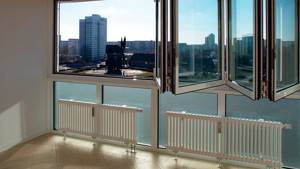
For calculations, you will need the area of the heated room and the thermal power of one section of the battery. The required data is provided by the equipment manufacturer. When calculating, the standard for heating residential premises is taken into account - 100 W per 1 m2.
K = S x 100 / P, where:
- P – power of one section;
- S – room area;
- K – number of sections.
This calculation method is relevant for cast iron, aluminum and bimetallic batteries. We must not forget about heat loss. If the room is corner or has a balcony, it is worth increasing the calculated amount by 20%.
By volume
Accurate calculations in a room with a high ceiling are performed by volume. Heating standards for 1 cubic meter m are 41 W. Formula:
K = V x 41 / P, where:
- V – volume of the room (area multiplied by the height of the ceiling);
- P – thermal power of 1 section;
- K – total number of sections.
When receiving a number with a fraction, the value is rounded up.
Install yourself: pros and cons
You should immediately warn that without experience in working and handling tools you should not take on this work yourself. Wrong choice of model, poor-quality assembly of sections and installation of radiators at the place of their operation can lead already at the beginning of the heating season to sad consequences such as destruction of devices, their connections and flooding of rooms with hot water.
It is advisable to start learning from an experienced worker, or even better to seek help from professionals. They will make an accurate thermal calculation, select and install the necessary heating radiators.
Heating radiators. How to choose?
The best manufacturers of heating radiators - which company to choose
There are many companies on the heating appliance market. Not all of them produce high quality products, so the name of the manufacturer must be taken into account when choosing.
We recommend choosing radiators from well-known companies, such as:
- Rifar.
- Global.
- Conner.
- Kermi.
Recommendations: 10 Best Aluminum Radiators
10 best steel radiators
20 best heating radiators
For a private house or apartment?
There are dozens and hundreds of companies specializing in the production of radioactive materials. The competition is crazy. Marketers are coming up with new arguments in favor of their products. This makes the choice of characteristics richer, and making a purchase more difficult for the average buyer. Let's start with the simplest thing.
If you need a device for a private house or apartment with an individual heating system, then choose by power and design. Those. We saw a model we liked in appearance, selected it based on power/size – and that’s it. For an apartment in a multi-storey building, where the coolant is supplied through the pipes of a centralized heating system, you also need to take into account the operating pressure set by the manufacturer. It should not be lower than 10-12 atmospheres. Otherwise, the structure will tear when water is supplied.
Now let’s look at the types of heating radiators, traditionally presenting the data in the form of a “tiny” table.
Device options and their features
| Comparison criterion | Varieties | Characteristics |
| Execution | Sectional |
|
| Tubular |
| |
| Panel |
| |
| Radiator material | Cast iron |
|
| Steel |
| |
| Aluminum |
| |
| Bimetal (steel+aluminum) |
| |
| Copper |
| |
| Gasket material | Silicone | Withstands high temperatures, effectively compensating for the expansion of metal structures. Ideal for low pressure heating systems, for example in private homes. |
| Paronitis | Paronite is pressed rubber mixed with asbestos and other components. Durable, withstands high temperatures. It is most often used in centralized heating systems. | |
| Fluoroplastic | A product made of heat-resistant polymer that can be installed without lubrication. Withstands exposure to any type of coolant. | |
| Cardboard | Impregnated with oil paint, special cardboard successfully copes with its function in aluminum and bimetallic RO installed in private homes. | |
| Coolant | Water | We are not talking about plain water, but about specially prepared water. This is exactly what circulates in the centralized heating system. It limits the content of hardness salts (due to which salt deposits form in the pipes - scale) and oxygen (due to which the material corrodes and breaks down). Water requirements in the EU and the Russian Federation are different, so when purchasing a foreign-made heating radiator, it is recommended to take into account the chemical composition of the water in your heating system. If desired, you can find it out at the Housing Office. |
| Antifreeze | Antifreezes or “anti-freeze” agents are used for systems with an individual heating circuit. They are needed if there is a risk of the coolant freezing due to the boiler being turned off. As you know, coolant is always in the system. If, for example, in winter the water in the system freezes, then due to expansion it will rupture the pipes, radiator, etc. Antifreeze does not freeze at average sub-zero temperatures. Ethylene glycol, propylene glycol, and alcohol solutions can serve as such coolants. | |
| Installation location | Stationary | Traditional heating radiators installed in most apartments. Mounting to the wall is carried out using special pin or corner brackets |
| Floor-standing | The same as stationary devices, only they are installed on special legs. | |
| Operating pressure* | up to 10 atm. | Such values are predominantly typical for panel-type devices. |
| up to 20 atm. and higher | For tubular and sectional RO. | |
| Center distance | 350, 400, 500, 600, 700 mm | The distance between the axes of horizontal collectors, along which a device is selected for connection to the existing pipe distribution. |
| Connection method | Lateral one-sided. (subtype of side connection) | The most common and effective solution in terms of using the capabilities of RO. Connection from the side: from above - to the pipe supplying coolant, from below - to the outlet. |
| Diagonal (subtype of lateral connection) | Most often used when connecting long devices (from 2 m and above), which allows the coolant to be evenly distributed throughout the entire volume of the structure. Inlet from above, outlet from the lower opposite side. | |
| Saddle (subtype of side connection) | For sectional ROs when it is impossible to use other methods. Inlet and outlet from the bottom on opposite sides of the device. In this case, the heat exchanger power may drop by 10-20%. | |
| Lower | For connecting panel RO with hidden pipe routing under the floor. Inlet and outlet from below at a short distance. The efficiency of the radiator is lower than with lateral and diagonal connections. | |
| Thermal power** | values in a wide range | Characterizes the radiator’s ability to transfer a certain amount of heat from the coolant to the room per hour of operation. It depends not only on the size and design of the RO, but also on the temperature of the coolant, as well as the air in the room. |
| Dimensions | On average: height from 260 to 800 mm, width from 270 to 1800 mm, depth from 50 to 100 mm | Directly affect the thermal power of the device, because The volume of coolant circulating in the device depends on this. |
* Before choosing a device, you need to check with the housing office about the maximum pressure in the heating system. Remember that all radiators except aluminum ones are suitable for a centralized heating system!
** We are often asked about how to choose the right heating radiator based on power. To make life easier for you and yourself, we have developed a convenient calculator. Enjoy it for your health!
For those who want to estimate the thermal power on their own, you can use the following method. We determine the required values per unit area of the room: 100 W/m2 – one window and one external wall; 120 W/m2 – one window and two external walls (corner room); 130 W/m2 – two windows and two external walls (corner room). For example, there is a corner room of 20 m2 with two windows. Then the approximate power of the RO will be: 20 × 130 = 2600 W. Let's make an allowance for the fact that the nameplate characteristics of radiators are tied to the ideal operating conditions of the device - 10% is quite enough. In total, we get the required thermal power: 2600 × 1.1 = 2860 W.
All that remains is to decide on the desired model, which you can find among the 20 devices we have selected.
Brief description of RO models from the rating
| Brand and country of manufacture | Model and section/panel dimensions (W×H×D) | Material, rated heat flux per section/panel, W | Approximate price per unit/section |
| 1. Global (Italy) | STYLE PLUS 500 (80×575×95) | bimetal, 185 | from 1041 rub. |
| 2. RIFAR (RF) | ALP-500 (81×570×75 mm) | bimetal, 158 | from 630 rub. |
| 3. SIRA (Italy) | RS 500 (80×572×95) | bimetal, 201 | from 850 rub. |
| 4. RIFAR (RF) | Monolit 500 (80×577×100) | bimetal, 196 | from 850 rub. |
| 5. Royal Thermo (Italy) | PianoForte 500 (80×591×100) | bimetal, 185 | from 1500 rub. |
| 6. Global (Italy) | ISEO 500 (80×582×80) | aluminum, 180 | from 790 rub. |
| 7. Thermal (RF) | Standard Plus 500 (79×531×72) | aluminum, 198 | from 400 rub. |
| 8. Oasis (RF) | Al 500/80 (79×531×72) | aluminum, 170 | from 420 rub. |
| 9. Sira (Italy) | ALICE ROYAL 95/500 (80×580×95) | aluminum, 190 | from 560 rub. |
| 10. Royal Thermo (RF) | Indigo 500 (80×591×100) | aluminum, 185 | from 630 rub. |
| 11. Buderus (Germany) | Logatrend K-Profil 33 300 1200 (1200×300×155) | steel, 670 | from 2000 rub. |
| 12. KZTO (RF) | Harmony 2-500-12 (70×545×80) | steel, 180 | from 2250 rub. |
| 13. Lideya (Belarus) | type 22 500×1000 LU 22-510 (1000×500×47) | steel, 697 | from 2850 rub. |
| 14. Kermi (Germany) | FKO 22 0510 (1000×500×100) | steel, 965 | from 2650 rub. |
| 15. Viadrus (Czech Republic) | Style (60×580×130) | cast iron, 70 | from 1500 rub. |
| 16. MZOO (Belarus) | MS-140M-05 (104×588×140) | cast iron, 160 | from 500 rub. |
| 17. EXEMET (RF) | Modern 3-745/600 (45×745×100) | cast iron, 102 | from 2000 rub. |
| 18. Terma (Poland) | Aero H (325×900) | steel, 290 | from 41,000 rub. |
| 19. Arbonia (Switzerland, Germany) | Karotherm KM90 (500×943×22) | steel, 481 | from 100,000 rub. |
| 20. GuRaTec (Germany) | Apollo 765/05 (76×768×250) | cast iron, 145 | from 6600 rub. |
In addition to the heat exchanger itself, do not forget about the control valves (thermal head) and the Mayevsky tap (if not included), which must be purchased separately. In some cases, the same applies to installation kits. Single-pipe heating systems will require a bypass.
We offer you a small rating that contains the best models of heating radiators. To make it easier to compare, we tried to select devices with the same number of sections - most often there will be 6 of them. This border solution is most in demand for standard apartments. All prices are for comparison purposes only.
Tubular radiators
Tubular radiators
This type is also called column radiators. The most efficient type in terms of heat transfer is two steel collectors connected by pipes (columns). The simplest type is familiar to many from the design of a heated towel rail for bathrooms. Higher wall thickness and fewer welds give certain advantages to column batteries compared to panel batteries.
Plate water heating radiators are also distinguished separately. But in principle, this type of tubular structure, on the collectors of which plates are installed, is more often called a water convector; the increased contact area with the air flow leads to the fact that the main part of the thermal energy comes not from radiation (radiation), but from convection.
Panel radiators
Panel radiators
Structurally, a panel heating radiator consists of two profiled steel plates connected by welding.
The combination of a large internal cross-section, high heat transfer and low inertia allows us to speak about the acquisition of the best performance qualities of cast iron and bimetallic radiators. That is, panel radiators in water heating systems can operate at low coolant velocities (for example, in a gravity heating system) and quite accurately respond to the signal from the automation when adjusting the temperature.
But it is the material and production technology that limit the scope of application of panel radiators. Welds do not withstand high pressure well enough and can fail under the influence of corrosion and water hammer. Therefore, they are usually used in heating systems of a private home, with low pressure and controlled quality of the coolant.
Technical characteristics of heating radiators
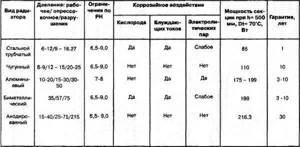
The range of heating radiators today allows you to take an individual approach to the configuration of any heating system. Experts recommend paying attention, first of all, to the technical characteristics and recommended operating conditions of the radiator.
Overview of the main features of radiators
So that you can see all the information in the most visual form, a table is presented to you - a comparison of heating radiators is presented in it on a scale from one to four pluses, depending on how much a particular feature is inherent in a particular option
| Cast iron batteries | Aluminum options | Bimetallic batteries | Steel panel products | Steel tubular elements | Convectors | |
| Light weight | + | +++ | +++ | +++ | +++ | +++ |
| Corrosion resistance | +++ | + | +++ | + | ++ | +++ |
| Heat transfer indicators | + | +++ | +++ | +++ | ++ | ++++ |
| Pressure resistance | +++ | ++ | +++ | + | ++ | +++ |
| Attractive view | + | +++ | +++ | ++ | ++++ | +++ |
| Thermal inertia | +++ | + | + | + | + | + |
| Easy to care for | ++ | ++ | ++ | +++ | +++ | + |
| Price | +++ | ++ | + | ++++ | + | ++ |
Based on this data, you can see the strengths and weaknesses of one or another option, the table shows that there is no ideal option, each has its own strengths and weaknesses, so the choice depends on you.
Important! If you have chosen a specific solution, it is important to purchase quality products, so choose products from brands that have been on the market for a long time and have proven themselves well among buyers.
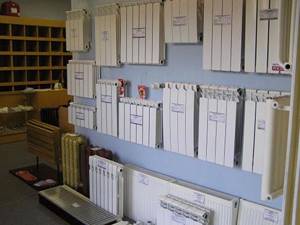
It is important to choose the best solution from a particular group of radiators
Copper radiators
The only drawback of a copper radiator is its price. Copper is a fairly expensive metal, so installing heating systems using copper batteries will not be affordable for everyone.
Otherwise, copper radiators are full of advantages:
- Heat transfer is twice as high as aluminum, and 5-6 times higher than steel or cast iron.
- A small volume of coolant ensures heating of the battery in 3-4 minutes. For individual heating, this provides significant savings.
- Copper radiators have low inertia, which allows the use of thermostats.
- Copper has the greatest corrosion resistance. Thanks to the oxide layer that forms on the inner surface of the copper battery already in the first few days of operation, the radiator is reliably protected from chemical and even mechanical damage by the coolant.
Copper radiators are made from seamless pipes supplemented with plate fins. Decorative casings made of wood or aluminum make their design even more expressive.


